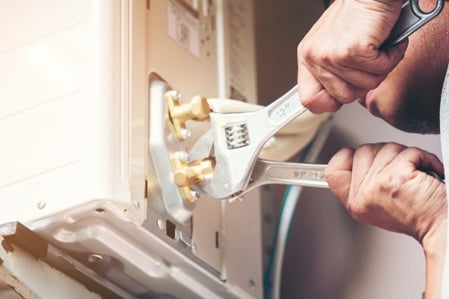Modern HVAC systems are designed with low-toxicity refrigerants such as R-410a, but even these substances can be dangerous if their concentration becomes too high. HVAC engineers must consider the potential amount of refrigerant if there is a leak, ensuring it remains below the refrigerant concentration limit (RCL).
The RCL value indicates an allowable weight of refrigerant per cubic foot of room volume (lb/ft3). As long as the concentration remains below the RCL, dangerous effects are avoided: oxygen deprivation, flammability, cardiac sensitization, etc. Once these effects are avoided, occupants can easily escape the affected area.
To get an idea of how dangerous a non-toxic or low-toxicity substance can be, consider water. While water is vital, it can cause drowning because it displaces air and is unbreathable – the same principle applies to any other liquid or gas that displaces air.
Make sure your HVAC system is designed for safe operation.
Safety Standards for Refrigerants in HVAC Systems
The American Society of Heating, Refrigerating, and Air-Conditioning Engineers (ASHRAE) has developed standards that document best practices in the HVAC industry. These cover topics such as the safe use of refrigerants, adequate ventilation of commercial buildings, temperature and humidity control , as well as measures that minimize energy and water consumption. In particular, the following standards address security topics:
-
ASHRAE 15-2004: Safety Standard for Refrigeration Systems
-
ASHRAE 34-2007: Designation and Safety Classification of Refrigerants
R-410a refrigerant used in VRF Systems has the safest rating according to ASHRAE standards, along with R-22, R-134a, and R-407c. However, even a safe refrigerant can be dangerous when a large leak displaces the air in a room, creating a suffocation hazard. The refrigerant concentration limit (RCL) for R-410a is 0.025 pounds per cubic foot.

To maximize safety, ASHRAE standards assume the worst-case scenario in their design requirements – having the full refrigerant charge of an HVAC system released into a small room for a short period of time. The refrigerant level after a leak is determined by two main factors:
-
The amount of refrigerant used by HVAC equipment.
-
The volume of air available for dispersion and dilution. Rooms with the lowest air volume are the most critical.
The refrigerant concentration calculated for each room cannot exceed the RCL. There are also applications where the permitted limit is reduced to 50% of the RCL – some examples are nursing homes, nursing homes and hospitals.
Brief Overview of the RCL Verification Process
Once the dimensions of all areas of the building are known, HVAC engineers calculate the air volume of the smallest rooms. They then divide the system refrigerant charge by this volume.
If the calculated value exceeds the RCL, the installation does not meet ASHRAE standards and must be redesigned. As mentioned previously, the RCL for R-410a is 0.25 lb/ft3. There are many ways to reduce the refrigerant concentration during a leak:
-
Increase the dimensions of rooms where the concentration exceeds the RCL, or take advantage of the area above the ceiling to enlarge the room.
-
Modify the piping system to reduce the refrigerant charge.
-
Increase the air volume with measures such as transfer ducts between rooms, lowered doors, grilles on doors or walls, etc.
Professional HVAC engineers can design mechanical systems to meet all requirements of ASHRAE standards and local building codes. They can also optimize energy efficiency , achieving a permanent reduction in your gas and electricity bills. In a nutshell, professional services ensure your installation is efficient and compliant.

